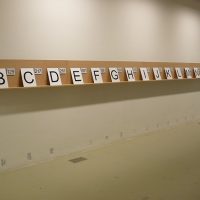The central motif of Kalifornia is the conceptual language used by contemporary visual arts ” the works are exposed in the confrontative dynamics between the comprehension and incomprehension of this language: the deconstructive artistic operation of the exhibitors accumulates a mass of visual and verbal signs, nominators and meanings in their works by snuffing out the reassuring, comprehensible messages. At the same time, the works which were tactically disseminated in their unraveled forms throughout the exhibition space create an interaction in an entirely new and liberating way, according to a new code of shape, language, and method and whisk away their recipients to an entirely uncharted terrain.
The latent Americanism in the title of the exhibition refers to the myth of California, according to which California is still the modern land of promise and opportunities, the widely used symbol of the hope and freedom of self-realization. Through conjuring up the utopian image of California, the exhibitors also reflect on the reality of Hungarian contemporary art and the opportunities for breaking free of this reality, as well as criticizing the self-defining mechanics of the domestic visual arts scene. The new works created for the occasion of the exhibition continue the attempts to renew the language of visual arts, with the help of ironic and psychedelic megalomania and institution critical titanism.



